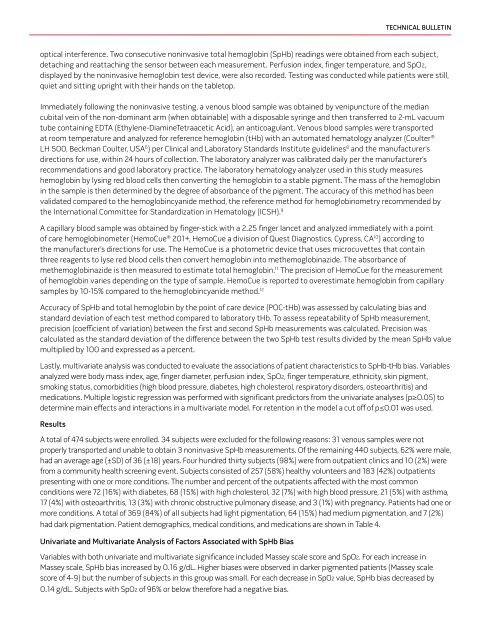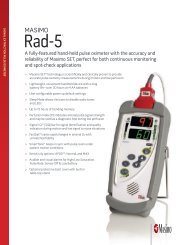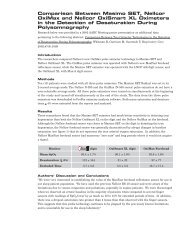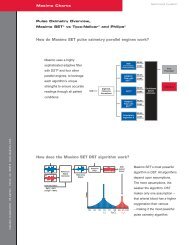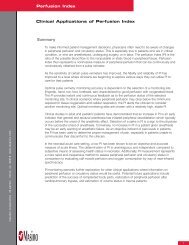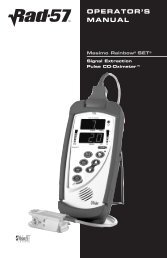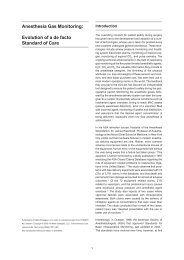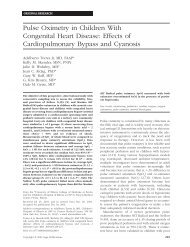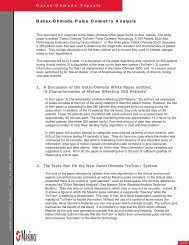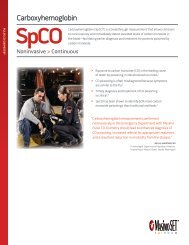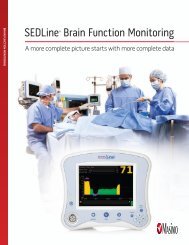Technical Bulletin, Pronto-7 Accuracy - Masimo
Technical Bulletin, Pronto-7 Accuracy - Masimo
Technical Bulletin, Pronto-7 Accuracy - Masimo
You also want an ePaper? Increase the reach of your titles
YUMPU automatically turns print PDFs into web optimized ePapers that Google loves.
<strong>Technical</strong> <strong>Bulletin</strong><br />
optical interference. Two consecutive noninvasive total hemoglobin (SpHb) readings were obtained from each subject,<br />
detaching and reattaching the sensor between each measurement. Perfusion index, finger temperature, and SpO2,<br />
displayed by the noninvasive hemoglobin test device, were also recorded. Testing was conducted while patients were still,<br />
quiet and sitting upright with their hands on the tabletop.<br />
Immediately following the noninvasive testing, a venous blood sample was obtained by venipuncture of the median<br />
cubital vein of the non-dominant arm (when obtainable) with a disposable syringe and then transferred to 2-mL vacuum<br />
tube containing EDTA (Ethylene-DiamineTetraacetic Acid), an anticoagulant. Venous blood samples were transported<br />
at room temperature and analyzed for reference hemoglobin (tHb) with an automated hematology analyzer (Coulter ®<br />
LH 500, Beckman Coulter, USA 6 ) per Clinical and Laboratory Standards Institute guidelines 8 and the manufacturer’s<br />
directions for use, within 24 hours of collection. The laboratory analyzer was calibrated daily per the manufacturer’s<br />
recommendations and good laboratory practice. The laboratory hematology analyzer used in this study measures<br />
hemoglobin by lysing red blood cells then converting the hemoglobin to a stable pigment. The mass of the hemoglobin<br />
in the sample is then determined by the degree of absorbance of the pigment. The accuracy of this method has been<br />
validated compared to the hemoglobincyanide method, the reference method for hemoglobinometry recommended by<br />
the International Committee for Standardization in Hematology (ICSH). 9<br />
A capillary blood sample was obtained by finger-stick with a 2.25 finger lancet and analyzed immediately with a point<br />
of care hemoglobinometer (HemoCue ® 201+, HemoCue a division of Quest Diagnostics, Cypress, CA 10 ) according to<br />
the manufacturer’s directions for use. The HemoCue is a photometric device that uses microcuvettes that contain<br />
three reagents to lyse red blood cells then convert hemoglobin into methemoglobinazide. The absorbance of<br />
methemoglobinazide is then measured to estimate total hemoglobin. 11 The precision of HemoCue for the measurement<br />
of hemoglobin varies depending on the type of sample. HemoCue is reported to overestimate hemoglobin from capillary<br />
samples by 10-15% compared to the hemoglobincyanide method. 12<br />
<strong>Accuracy</strong> of SpHb and total hemoglobin by the point of care device (POC-tHb) was assessed by calculating bias and<br />
standard deviation of each test method compared to laboratory tHb. To assess repeatability of SpHb measurement,<br />
precision (coefficient of variation) between the first and second SpHb measurements was calculated. Precision was<br />
calculated as the standard deviation of the difference between the two SpHb test results divided by the mean SpHb value<br />
multiplied by 100 and expressed as a percent.<br />
Lastly, multivariate analysis was conducted to evaluate the associations of patient characteristics to SpHb-tHb bias. Variables<br />
analyzed were body mass index, age, finger diameter, perfusion index, SpO2, finger temperature, ethnicity, skin pigment,<br />
smoking status, comorbidities (high blood pressure, diabetes, high cholesterol, respiratory disorders, osteoarthritis) and<br />
medications. Multiple logistic regression was performed with significant predictors from the univariate analyses (p≥0.05) to<br />
determine main effects and interactions in a multivariate model. For retention in the model a cut off of p≤0.01 was used.<br />
Results<br />
A total of 474 subjects were enrolled. 34 subjects were excluded for the following reasons: 31 venous samples were not<br />
properly transported and unable to obtain 3 noninvasive SpHb measurements. Of the remaining 440 subjects, 62% were male,<br />
had an average age (±SD) of 36 (±18) years. Four hundred thirty subjects (98%) were from outpatient clinics and 10 (2%) were<br />
from a community health screening event. Subjects consisted of 257 (58%) healthy volunteers and 183 (42%) outpatients<br />
presenting with one or more conditions. The number and percent of the outpatients affected with the most common<br />
conditions were 72 (16%) with diabetes, 68 (15%) with high cholesterol, 32 (7%) with high blood pressure, 21 (5%) with asthma,<br />
17 (4%) with osteoarthritis, 13 (3%) with chronic obstructive pulmonary disease, and 3 (1%) with pregnancy. Patients had one or<br />
more conditions. A total of 369 (84%) of all subjects had light pigmentation, 64 (15%) had medium pigmentation, and 7 (2%)<br />
had dark pigmentation. Patient demographics, medical conditions, and medications are shown in Table 4.<br />
Univariate and Multivariate Analysis of Factors Associated with SpHb Bias<br />
Variables with both univariate and multivariate significance included Massey scale score and SpO2. For each increase in<br />
Massey scale, SpHb bias increased by 0.16 g/dL. Higher biases were observed in darker pigmented patients (Massey scale<br />
score of 4-9) but the number of subjects in this group was small. For each decrease in SpO2 value, SpHb bias decreased by<br />
0.14 g/dL. Subjects with SpO2 of 96% or below therefore had a negative bias.


